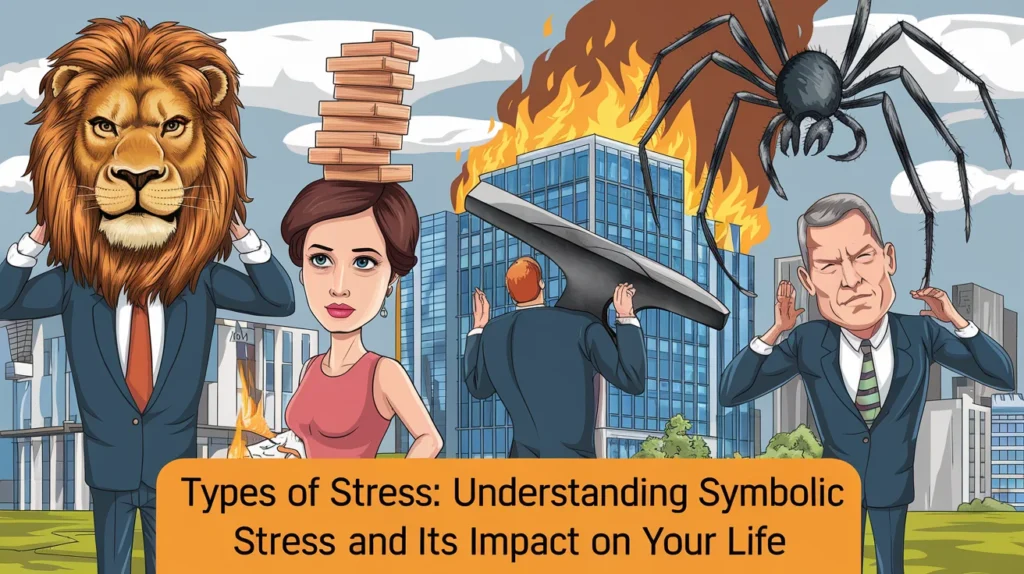Stress is an inevitable part of life. Whether it’s a looming deadline, a heated argument, or the pressure to meet societal expectations, stress manifests in various forms and affects us all. However, not all stress is created equal. While acute stress can be a fleeting response to immediate challenges, chronic stress can wreak havoc on your mental and physical health. And then there’s symbolic stress—a type of stress rooted in abstract or psychological factors like identity, cultural expectations, or societal norms.
In this comprehensive guide, we’ll explore the different types of stress, with a special focus on symbolic stress. We’ll dive into the science behind stress hormones, the signs and symptoms of stress, and practical strategies for managing it. By the end of this article, you’ll have a deeper understanding of how stress works and how to combat it effectively.
What is Stress?
Stress is the body’s natural response to perceived threats or challenges. It triggers a cascade of physiological changes designed to help us survive and adapt. However, when stress becomes chronic or overwhelming, it can lead to serious health problems.
There are several types of stress, each with its own causes and effects:
- Acute Stress: Short-term stress triggered by immediate challenges.
- Chronic Stress: Long-term stress caused by ongoing pressures.
- Episodic Acute Stress: Frequent episodes of acute stress.
- Symbolic Stress: Stress tied to abstract or psychological factors, such as societal expectations or identity struggles.
Understanding these types of stress is crucial for managing their impact on your life.
Types of Stress: A Detailed Breakdown
Acute Stress
Acute stress is the most common form of stress. It’s the body’s immediate response to a new challenge, event, or demand. Think of it as the “fight or flight” response in action.
- Causes: Deadlines, arguments, or sudden changes.
- Effects: Temporary spikes in cortisol and adrenaline, leading to heightened alertness and energy.
- Symptoms:
- Physical: Rapid heartbeat, sweating, headaches.
- Emotional: Irritability, anxiety, or temporary mood swings.
While acute stress is short-lived, frequent episodes can lead to episodic acute stress or even chronic stress.
Chronic Stress
Chronic stress is a prolonged form of stress that persists over weeks, months, or even years. It often stems from ongoing situations that feel inescapable, such as financial struggles, toxic relationships, or unrelenting work pressure.
- Causes: Long-term unemployment, caregiving responsibilities, or systemic discrimination.
- Effects:
- Mental: Anxiety, depression, and emotional numbness.
- Physical: Fatigue, insomnia, digestive issues, and weakened immune function.
- Long-term implications: Chronic stress is linked to serious health conditions, including heart disease, diabetes, and autoimmune disorders.
Episodic Acute Stress
Episodic acute stress occurs when someone frequently experiences acute stress. This is common in individuals with chaotic lifestyles or perfectionist tendencies.
- Causes: Overcommitment, poor time management, or a tendency to worry excessively.
- Symptoms:
- Physical: Tension headaches, high blood pressure.
- Emotional: Irritability, a sense of being constantly overwhelmed.
- Connection to chronic stress: If left unaddressed, episodic acute stress can evolve into chronic stress.
Symbolic Stress
Symbolic stress is a unique type of stress rooted in abstract or psychological factors. Unlike acute or chronic stress, which are often tied to tangible events, symbolic stress arises from societal expectations, cultural pressures, or identity struggles.
- Examples:
- Feeling inadequate due to imposter syndrome.
- Struggling with gender roles or racial discrimination.
- Pressure to conform to societal beauty standards.
- Unique challenges: Symbolic stress is often invisible but deeply impactful. It can lead to feelings of alienation, self-doubt, and emotional exhaustion.
- Intersection with other types of stress: Symbolic stress can exacerbate acute or chronic stress, creating a vicious cycle.
Stress Hormones: The Science Behind Stress
Stress triggers a complex hormonal response designed to help us cope with challenges. Here’s a breakdown of the key players:
Key Stress Hormones
- Cortisol: The primary stress hormone, responsible for regulating energy and the stress response.
- Adrenaline: Triggers the “fight or flight” response, increasing heart rate and energy levels.
- Norepinephrine: Works alongside adrenaline to heighten alertness.
- Dopamine and Serotonin: These “feel-good” hormones are often disrupted by chronic stress.
How Stress Hormones Affect the Body
- Short-term effects: Increased heart rate, heightened senses, and energy surges.
- Long-term effects: Hormonal imbalances, weight gain, and mental health disorders.
The Role of Hormones in Symbolic Stress
Symbolic stressors, such as societal expectations or identity struggles, can trigger the same hormonal responses as physical threats. For example, the pressure to meet beauty standards can lead to chronic cortisol elevation, contributing to anxiety and depression.
Signs and Symptoms of Stress
Recognizing the signs of stress is the first step toward managing it. Here’s what to look for:
Acute Stress Symptoms
- Physical: Headaches, sweating, rapid heartbeat.
- Emotional: Irritability, anxiety, or temporary mood swings.
Chronic Stress Symptoms
- Physical: Fatigue, insomnia, digestive issues.
- Emotional: Persistent anxiety, depression, or emotional numbness.
Symbolic Stress Symptoms
- Emotional: Feelings of inadequacy, self-doubt, or alienation.
- Behavioral: Overcompensation, withdrawal, or perfectionism.
Stress Management: Effective Techniques and Strategies
Managing stress requires a multifaceted approach. Here are some proven strategies:
Mindfulness Practices
- Meditation: Helps calm the mind and reduce cortisol levels.
- Deep breathing: Activates the parasympathetic nervous system, promoting relaxation.
- Grounding techniques: Focus on the present moment to reduce anxiety.
Time Management and Prioritization
- Tools: Use planners or apps to organize tasks.
- Methods: Break tasks into smaller, manageable steps.
Physical Exercise
- Role of exercise: Reduces cortisol levels and boosts endorphins.
- Recommended routines: Yoga, cardio, and strength training.
Emotional Resilience Building
- Techniques: Journaling, therapy, and self-compassion practices.
- Case study: A 2022 study found that individuals who practiced self-compassion experienced a 30% reduction in stress levels.
Workplace Stress: Coping and Management
Workplace stress is a leading cause of chronic stress. Here’s how to manage it:
Common Causes of Workplace Stress
- High workloads, lack of control, and poor work-life balance.
Strategies for Managing Stress at Work
- Set boundaries, communicate effectively, and delegate tasks.
Leadership and Team Management
- Leaders can reduce stress by fostering empathy and support.
- Create a culture that addresses symbolic stressors, such as diversity and inclusion initiatives.
Chronic vs. Acute Stress: Key Differences
- Chronic stress: Long-term wear and tear on the body and mind.
- Acute stress: Temporary spikes in stress hormones.
- Symbolic stress: Can manifest as both acute and chronic stress.
Building Emotional Well-Being and Mental Fitness
- Importance of emotional health: Strong emotional health enhances stress resilience.
- Practical steps: Therapy, support groups, and self-care routines.
- Addressing symbolic stress: Identify and challenge internalized stressors.
Conclusion: Fighting Stress with Awareness and Action
Stress is a complex and multifaceted experience, but understanding its different forms—especially symbolic stress—can empower you to take control. By implementing the strategies outlined in this article, you can reduce stress and improve your overall well-being.
Remember, stress management is not a one-size-fits-all solution. Experiment with different techniques, seek support when needed, and prioritize your mental and physical health.


